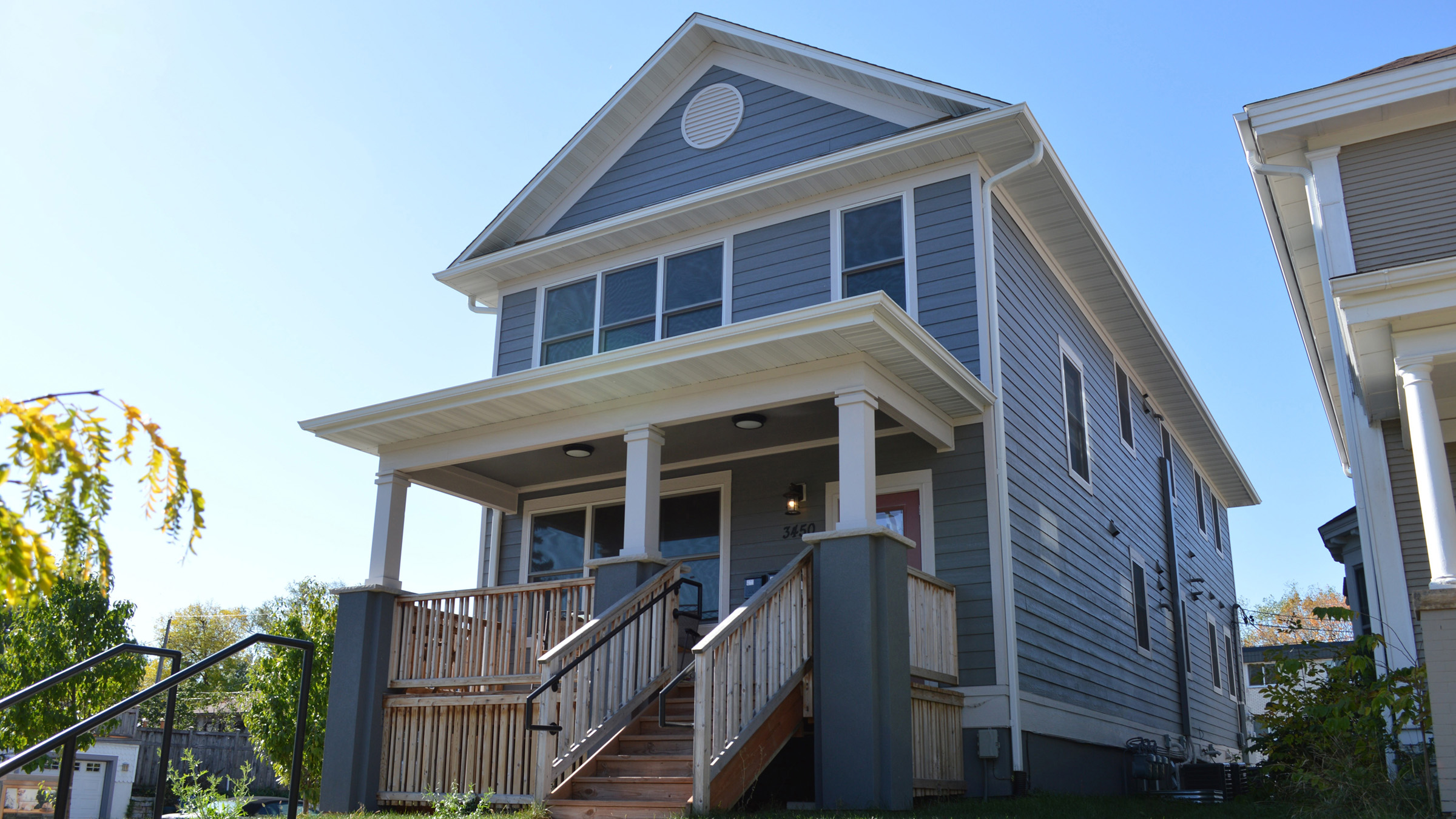In October 2019, the City of Minneapolis made national headlines for approving its 2040 Comprehensive Plan, which contained an extensive set of changes to planning around residential development and land use. Several years in, what effect has the plan had on housing and housing affordability in the city? A tracking tool developed by the Federal Reserve Bank of Minneapolis shows little change so far; expectations are that any evidence of impact will take more time after the plan’s implementation to appear.
Building a dashboard to track the outcomes
In its most noted provision, the 2040 Plan allowed duplexes and triplexes in areas that had previously only allowed single-family detached houses without additional approvals. But the plan also advanced a rich set of other housing policies: rezoning for higher density along transit and other corridors, minimum height requirements for downtown development, and expanded investments in affordable housing. Connecting the land use reforms to housing affordability, the City of Minneapolis observed in the 2040 Plan, “allowing for growth is a prerequisite to addressing market rate housing production as well as affordable housing production and preservation. Allowing for an increase in the overall housing supply is intended to result in overall lower housing costs than would occur if no more supply was built.”
As the 2040 Plan was being passed, the Minneapolis Fed saw an opportunity to examine the impacts of land use and zoning on housing affordability, and built a data dashboard that would track the plan’s outcomes. As new data become available, the Minneapolis Fed updates the dashboard and analyzes any changes, and will continue to do so throughout the lifetime of the plan.
Telling the story of the 2040 Plan in goals and indicators
The impact of the 2040 Plan can be assessed through three broad questions: Does the plan lead to more housing? More affordable housing? And more housing choice for more people? Minneapolis Fed staff sought input from the City of Minneapolis on which indicators related to those three questions the dashboard should track. The dashboard-development team completed this step before any changes resulting from the plan’s implementation were likely to have an impact on available data, hence minimizing the risk of selecting indicators that tell a biased story. In the end, 11 housing indicators grouped under three goals were selected:
Goal 1: More housing
- New duplex/triplex/fourplex structures permitted
- New multifamily housing
- Housing composition: mix of housing structure types
Goal 2: More affordable housing
- New affordable housing
- Stock of affordable housing
- Housing cost burden
- Price of housing measured by median rent
Goal 3: More equitable housing
- Housing choice
- Income segregation
- Rent dissimilarity
- Isolation of White residents
Supplementing these 11 indicators are contextual indicators that provide additional sources of data and disaggregate the main indicators by geography and race or ethnicity. In total, the dashboard tracks 39 indicators. (For details on how the indicators were constructed, see the dashboard’s Technical Appendix.)
Finding the right comparison groups
To separate the effects of the 2040 Plan from other economic trends, the Minneapolis Fed implemented a sophisticated econometric approach called synthetic control that’s designed to assess how Minneapolis is faring relative to an estimated scenario in which there was no 2040 Plan. This method compares outcomes in Minneapolis to outcomes in a control group of comparison cities that show a close pre-2020 match with Minneapolis housing trends. In identifying cities whose historical trends are a match, the Minneapolis Fed drew on 126 cities that are roughly similar to Minneapolis in size (population 150,000–2,000,000), had no similar land use policy as of 2019, would see no geographic spillover effects from Minneapolis, and, like Minneapolis, are principal cities in their metropolitan areas.
By creating a counterfactual—that is, a hypothetical situation showing what would have happened in Minneapolis but for the adoption of the 2040 Plan—this approach disentangles the impact of the 2040 Plan from external events that play out across the whole economy. With each indicator having a stable comparison group that has a close fit to historical trends in Minneapolis, this approach provides a solid foundation of evidence for evaluating the impact of the 2040 Plan.
Data do not yet demonstrate a significant impact of the 2040 Plan on development patterns
As expected due to timing lags in relevant data and staggered policy implementation, four years after the adoption of the 2040 Plan the dashboard does not yet show changes in housing affordability beyond what might have occurred without the plan. Compared to housing markets in similarly sized cities, the dashboard shows that the housing market in Minneapolis continues to mirror national trends.
Currently, five of the 11 indicators have recent-enough data for national comparisons. Among them, one indicator, housing choice, is demonstrating a statistically significant difference from its comparison group. Housing choice is defined as the share of homes in Minneapolis that are affordable for very low-income households to buy. Over the three-year period ending in 2022, 20.3 percent of homes in Minneapolis were affordable to households earning 50 percent of area median income (AMI)—compared to 18.1 percent in the comparison group. Although this difference is a statistically significant improvement compared to what would have been without the 2040 Plan, the 20.3 percent is still well below Minneapolis’ recent peak of 27.8 percent in 2014.
While Minneapolis showed strong multifamily housing construction through the late 2010s and early 2020s—peaking with 4,646 new units permitted in 2019, just prior to the implementation of the city’s inclusionary zoning policy that requires affordable units within new housing developments—the 2040 Plan’s passage doesn’t mark any clear change in this trend. The Minneapolis Fed’s dashboard shows no statistically significant difference in the volume of multifamily housing construction compared to what would have happened but for the plan in Minneapolis.
For the “New multifamily housing” indicator in particular, the lagged implementation of three key policies may have delayed the plan’s full effects. On January 1, 2021, exactly one year after the 2040 Plan took effect, the city implemented its built form policies, which are a set of city-wide zoning overlay districts regulating built form, or the attributes of any residential structure built in the city, including height, floor area, and lot size. Next, the city completely eliminated parking minimums as of May 22, 2021, thus reducing construction and development costs for new housing. Finally, on July 1, 2023, Minneapolis adopted its Land Use Rezoning Study, which aligned zoning districts with the direction of the 2040 Plan and streamlined the regulatory process for new housing. With few data available so far that reflect the second half of 2023, more time is needed before we can quantitatively observe the impacts of these policy changes.
The price of housing in Minneapolis, as measured by the median rent, is tracking with the price of housing in the comparison group. From 2021 to 2022, the median rent in Minneapolis edged upward 3 percent, from $1,225 to $1,265, a slower increase than the 7 percent annual growth seen from 2019 to 2021. Meanwhile, in 2022 the dashboard’s comparison group had a median rent that was just $15 higher, at $1,280—a difference that is not statistically significant. Though different data sources suggest different levels of rent increase, they agree in that rent prices overall have increased in Minneapolis since 2020. The Zillow Observed Rent Index, also presented in the dashboard, shows an 8 percent increase over the four years from October 2019 (pre-plan adoption) to October 2023 (the most recent month for which data are available). And a third data source, CoStar, shows a less than 1 percent increase between fourth quarter 2019 and fourth quarter 2023.
Several key indicators in the dashboard do not have national comparisons due to a lack of comparable data. Most notably, the Minneapolis Fed has been tracking data on new duplexes, triplexes, and fourplexes permitted in Minneapolis since the beginning of 2020, when the 2040 Plan legalized duplexes and triplexes in areas that previously had single-family-only zoning. Note, however, that although tracking only duplexes and triplexes would better reflect what the 2040 Plan allows, data that are available to us do not distinguish among duplexes, triplexes, and fourplexes, nor do they reflect remodeling of existing properties that creates additional units. From 2020 to 2022, the city did not see an increase in housing permits for these “missing middle” types of housing, with 46 new two- to four-unit buildings permitted across the three years. Significantly, just 20 of the new duplexes and triplexes were built in areas that had been zoned for single-family housing prior to the 2040 Plan.*
Other outcomes reveal persistent, substantial distress among low-income residents. For example, housing cost burden among extremely low-income renters in Minneapolis, which the dashboard defines as the proportion of renters earning less than or equal to 30 percent of AMI who pay more than 30 percent of their income on housing costs, remains high. After a recent low of 80.2 percent in 2017, housing cost burden has crept upward since 2017 to 87.5 percent, matching the previous high from 2011. Despite the 638 new housing units affordable to extremely low-income households added to the city’s housing stock over 2020–2022, housing opportunities affordable to the lowest-income households have long been and continue to be scarce in Minneapolis.
More time to evaluate impact of 2040 Plan lies ahead
Given the long timelines of both the housing development process and data collection, the muted impacts of the 2040 Plan to date, as displayed in the Minneapolis Fed’s dashboard, are unsurprising. Navigating the structural changes to transform the Minneapolis housing market will take time. And complete comparative data will not be available for all 11 indicators until late 2025. However, when and if impacts start to appear in the Minneapolis Fed’s dashboard, our approach offers the best chance to reliably demonstrate any effects of the 2040 Plan, whether consistent with expectations or not.
A key barrier to observing further impacts in the short term is a Hennepin County District Court order that blocked the use of some aspects of the 2040 Plan as of November 4, 2023. As a result of the order, development of housing with three or more units (e.g., triplexes and up) is no longer permissible in the city in areas that had previously allowed only single-family homes and duplexes.
As more time passes after the full implementation of Minneapolis’ 2040 Plan, we will learn more about any impacts of these land use and zoning reforms. In the meantime, by continuing to update the 2040 Plan data dashboard, the Minneapolis Fed will closely track these important housing outcomes until the city updates its comprehensive plan later in this decade.
Endnote
* Due to data limitations, we are unable to identify new triplexes built in areas that had been zoned to allow duplexes prior to the 2040 Plan.
Libby Starling is Senior Community Development Advisor in Community Development and Engagement at the Federal Reserve Bank of Minneapolis. She focuses on deepening the Bank’s understanding of housing affordability, concentrating on effective housing policies and practices that make a difference for low- and moderate-income families in the Ninth Federal Reserve District.








